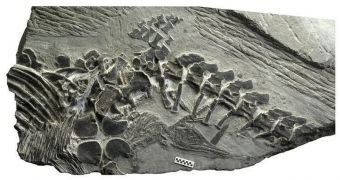Investigators at the University of California in Davis (UCD), led by prehistoric marine reptile expert Ryosuke Motani, uncovered in a new study the fossilized remains of an ancient reptile that appears to have given birth on land, in a manner to that seen in modern mammals.
Currently, reptiles do not carry out live births, but rather prefer to lay eggs. However, this was not always so. In the very distant past, reptiles too were able to produce living offspring directly. This ability apparently evolved up to 100 different times throughout history, and may evolve again.
This was again confirmed by the discovery of the new air-breathing sea creature, which lived in the Triassic era, some 250 million years ago. This means that the animals existed on Earth less than 3 million years after the Permian-Triassic extinction event, the largest and most devastating in history.
The specimen uncovered is part of a species called chaohusaurus, which is a type of ichthyosaur (which means fish lizard in Greek). These creatures were giant marine reptiles, which apparently featured members that could give birth to live offspring on land.
Researchers were fortunate enough to discover a female specimen of chaohusaurus, which died in the process of giving birth to three youngsters. Due to the fact that the fossil was extremely-well preserved, scientists were able to determine that the first offspring was being born head-first.
This is a monumental discovery, since air-breathing marine animals today tend to give birth tail-first, in order to reduce the risks of offspring suffocating under water. Also remarkable is the fact that the individual was giving birth on land, instead of at sea.
“Live births in ichthyosaurs may have taken place on land, instead of in the water, as some studies have previously suggested,” says Motani, who is also the author of a new study detailing the findings. The work is published in the latest issue of the open-access, peer-reviewed scientific journal PLoS ONE, NPR reports.
“This land-style of giving birth is only possible if they inherited it from their land ancestors. They wouldn't do it if live birth evolved in water,” the research adds, referencing the fact that ichthyosaurs may have evolved from land-trotting animals.

 14 DAY TRIAL //
14 DAY TRIAL //